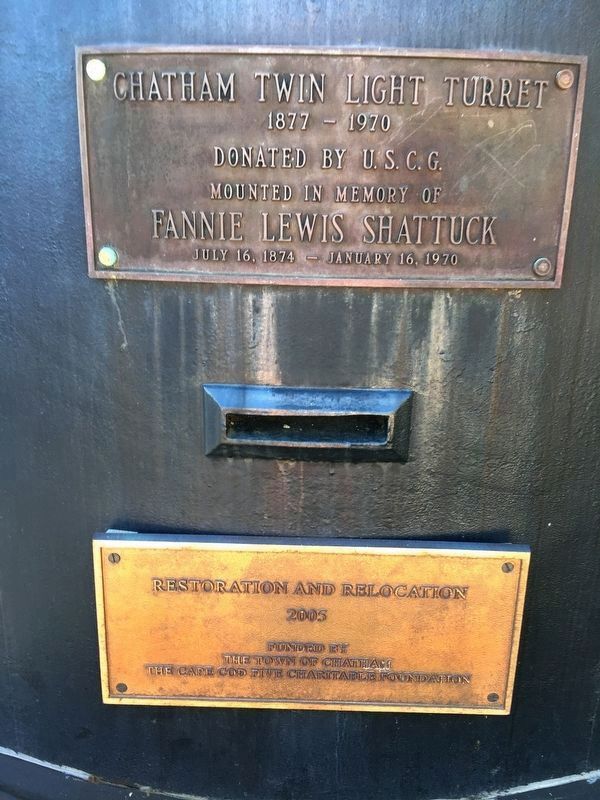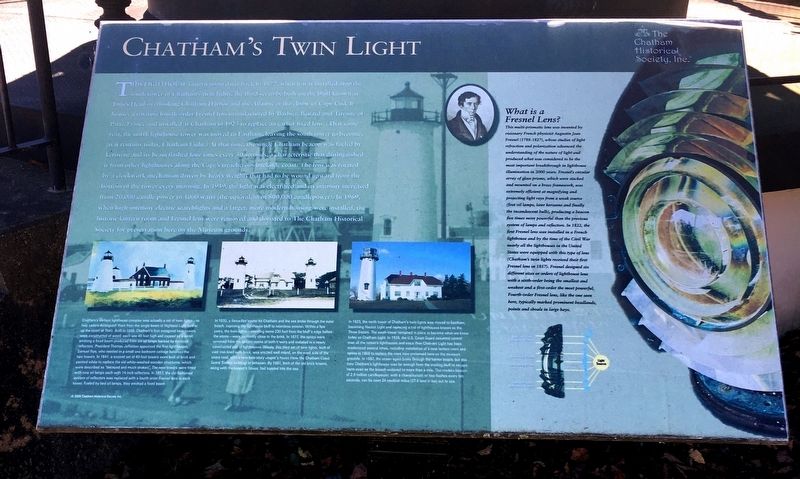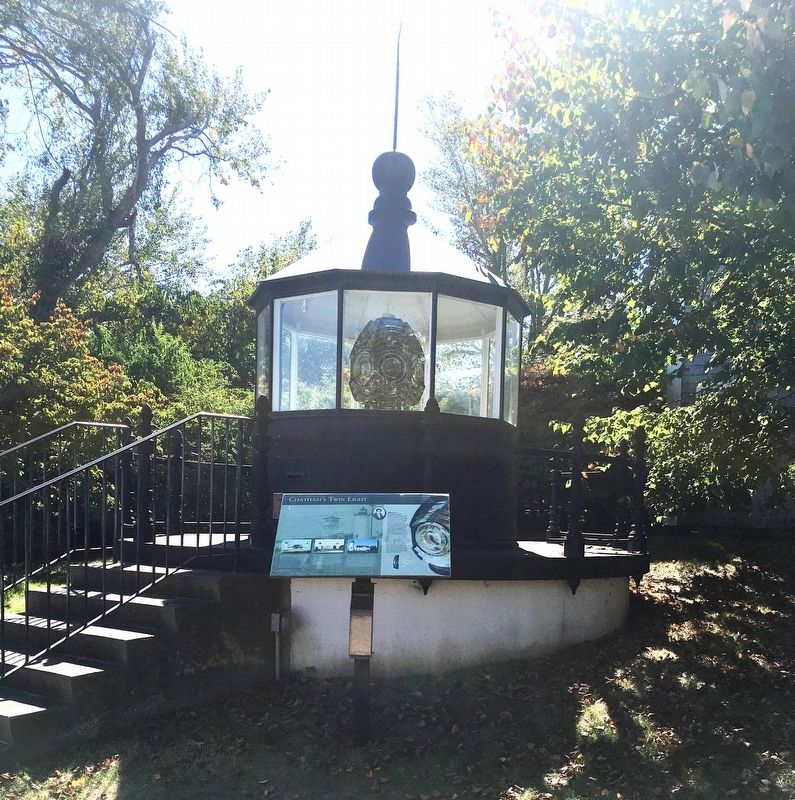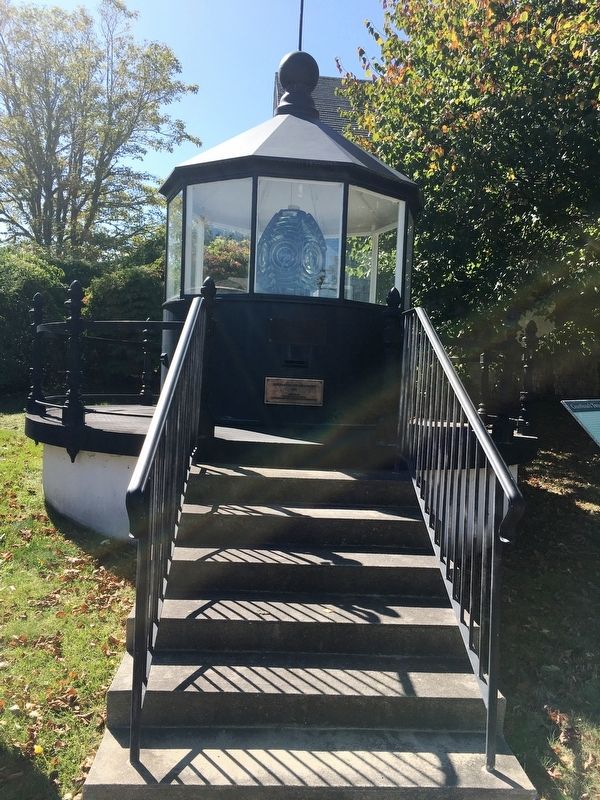Chatham in Barnstable County, Massachusetts — The American Northeast (New England)
Chathamís Twin Light
This Lighthouse lantern room dates back to 1887, when it was installed atop the south tower of Chathamís twin lights, the third set to be built on the bluff known as James Head overlooking Chatham Harbor and the Atlantic at the elbow of Cape Cod. It houses a rotating fourth-order Fresnel lens manufactured by Barbier, Bernard and Tirenne of Paris, France and installed at Chatham in 1923 to replace an earlier fixed lens. (That same year, the north lighthouse tower was moved to Eastham, leaving the south tower to become, as it remains today,. Chatham Light.) At that time , the single Chatham beacon was fueled by kerosene and its beam flashed four times every 30 seconds, a characteristic that distinguished it from other lighthouses along the Capeís treacherous backside coast. The lens was rotated by a clockwork mechanism driven by heavy weights that had to be wound upward from the bottom of the tower every morning. In 1939, the light was electrified and its intensity increased from 20,000 candle power to 1000 watts (the equivalent of 800,000 candlepower). In 1969, when high-intensity electric searchlights and a larger, more modern housing were installed, the historic lantern room and Fresnel lens were removed and donated to The Chatham Historical Society for preservation here on the Museum grounds.
Chathamís earliest lighthouse complex was actually a set of twin lights – to help sailors distinguish them from the single beam of Highland Light further up the coast at Truro. Built in 1608, Chathamís first octagonal twin towers were constructed of wood , each one 40 feet high and capped by a turret emitting a fixed beam produced from six oil lamps backed by mirrored reflectors. President Thomas Jefferson appointed the first light keeper, Samuel Nye, who resided in a small one-bedroom cottage between the two towers. In 1841, a second set of 40-foot towers were built of brick and painted white to replace the old white-washed wooden structures, which were described as “decayed and much shaken”. The new towers were fitted with nine oil lamps each with 14-inch reflectors. In 1857, the old-fashioned system of reflectors were replaced with a fourth order Fresnel lens in each tower. Fueled by lard oil lamps, they emitted a fixed beam.
In 1870, a fierce Noríeaster hit Chatham and the sea broke through the outer beach, exposing the lighthouse bluff to relentless erosion. Within a few years, the twin lights – standing some 230 feet from the bluffís edge before the storm – were perilously close to the brink. In 1877, the optics were removed from the lantern rooms of both towers and installed in a newly constructed pair of lighthouses. Wisely, this third set of twin lights, built of cast iron lined with brick, was erected well inland, on the west side of the shore Road, with a new two-story keeperís house (now the Chatham Coast Guard Station building) in between. By 1881, both of the old brick towers, along with the keeperís house, had toppled into the sea.
In 1923, the north tower of Chathamís twin light was moved to Eastham, becoming Nauset Light and replacing a trio of lighthouses known as the Three Sisters. The south tower remained in place to become what we know today as Chatham Light. In 1939, the U.S. Coast Guard assumed control over all the nationís lighthouses and since then Chatham Light has been modernized several times, including installation of a new lantern room and optics in 1959 to replace the ones now preserved here on the museum grounds. In 1987, the ocean again broke through the barrier beach, but this time Chathamís lighthouse was far enough from the eroding bluff to escape harm even as the beach widened to more than a mile. The modern beacon of 2.8 million candlepower, with a characteristic of two flashes every ten seconds, can be seen 24 nautical miles (27.6 land miles)out to sea.
What is a Fresnel Lens?
This multi-prismatic lens was invented by visionary French physicist Augustine Jean Fresnel (1788 – 1827), whose studies of light refraction and polarization advanced the understanding of the nature of light and produced what was considered to be the most important breakthrough in lighthouse illumination in 2000 years. Fresnelís circular array of glass prisms, which were stacked and mounted on a brass framework, was extremely efficient at magnifying and projecting light rays from a weak source (first oil lamps, later kerosene and finally the incandescent bulb), producing a beacon five times powerful than the previous system of lamps and reflectors. In 1822, the first Fresnel lens was installed in a French lighthouse in the United States were equipped with this type of lens. Chathamís twin lights received their first Fresnel lens in 1857). Fresnel designed six different sizes or orders of lighthouse lens with a sixth-order being the smallest and weakest and a first-order the most powerful. Fourth-order Fresnel lens, like the one seen here, typically marked prominent headlands, points, and shoals in large bays.
Erected by Chatham Historical Society.
Topics. This historical marker is listed in this topic list: Notable Buildings.
Location. 41° 40.394′ N, 69° 57.92′ W. Marker is in Chatham, Massachusetts, in Barnstable County. Marker is on Stage Harbor Road north of Inlet Road, on the right when traveling north. Located on the

Photographed By Brandon D Cross, October 4, 2020
4. Chatham Twin Light Turret Dedication Plaques
1877 – 1970
Donated by U.S.C.G.
mounted in memory of
Annie Lewis Shattuck
July 16, 1874 – January 16, 1970
( lower plaque )
2005
funded by
The Town of Chatham
The Cape Cod Five Charitable Foundation
Other nearby markers. At least 8 other markers are within walking distance of this marker. Chathamís Chimes (a few steps from this marker); The Atwood School (approx. ľ mile away); Samuel De Champlain (approx. 0.4 miles away); The Godfrey Windmill (approx. 0.4 miles away); History of Chatham (approx. 0.6 miles away); a different marker also named History of Chatham (approx. 0.6 miles away); The Josiah Mayo House (approx. 0.6 miles away); In Memory of the Pioneers of Chatham (approx. 0.7 miles away). Touch for a list and map of all markers in Chatham.
Also see . . .
1. Atwood Museum, home of the Chatham Historical Society. (Submitted on November 11, 2020, by Michael Herrick of Southbury, Connecticut.)
2. Chatham Light (Wikipedia). (Submitted on November 11, 2020, by Michael Herrick of Southbury, Connecticut.)
3. Fresnel lens (Wikipedia). (Submitted on November 11, 2020, by Michael Herrick of Southbury, Connecticut.)
Credits. This page was last revised on November 11, 2020. It was originally submitted on November 11, 2020, by Brandon D Cross of Flagler Beach, Florida. This page has been viewed 110 times since then and 13 times this year. Photos: 1, 2, 3, 4. submitted on November 11, 2020, by Brandon D Cross of Flagler Beach, Florida. • Michael Herrick was the editor who published this page.


